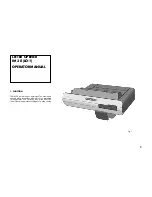
General Machinery Safety Instructions
1. Read the entire Manual before starting
machinery.
Machinery may cause serious injury if
not correctly used.
2. Always use correct hearing protection when
operating machinery.
Machinery noise may cause
permanent hearing damage.
3. Machinery must never be used when tired, or
under the influence of drugs or alcohol.
When
running machinery you must be alert at all times.
4. Wear correct Clothing.
At all times remove all loose
clothing, necklaces, rings, jewelry, etc. Long hair
must be contained in a hair net. Non-slip protective
footwear must be worn.
5. Always wear correct respirators around fumes
or dust when operating machinery.
Machinery
fumes & dust can cause serious respiratory illness.
Dust extractors must be used where applicable.
6. Always wear correct safety glasses.
When
machining you must use the correct eye protection
to prevent injuring your eyes.
7. Keep work clean and make sure you have good
lighting.
Cluttered and dark shadows may cause
accidents.
8. Personnel must be properly trained or well
supervised when operating machinery.
Make
sure you have clear and safe understanding of the
machine you are operating.
9. Keep children and visitors away.
Make sure
children and visitors are at a safe distance for you
work area.
10. Keep your workshop childproof.
Use padlocks,
Turn off master power switches and remove start
switch keys.
11. Never leave machine unattended.
Turn power off
and wait till machine has come to a complete stop
before leaving the machine unattended.
12. Make a safe working environment.
Do not use
machine in a damp, wet area, or where flammable
or noxious fumes may exist.
13. Disconnect main power before service
machine.
Make sure power switch is in the off
position before re-connecting.
14. Use correct amperage extension cords.
Undersized extension cords overheat and lose
power. Replace extension cords if they become
damaged.
15. Keep machine well maintained.
Keep blades
sharp and clean for best and safest performance.
Follow instructions when lubricating and changing
accessories.
16. Keep machine well guarded.
Make sure guards
on machine are in place and are all working
correctly.
17. Do not overreach.
Keep proper footing and
balance at all times.
18. Secure workpiece.
Use clamps or a vice to
hold the workpiece where practical. Keeping the
workpiece secure will free up your hand to operate
the machine and will protect hand from injury.
19. Check machine over before operating.
Check
machine for damaged parts, loose bolts, Keys and
wrenches left on machine and any other conditions
that may effect the machines operation. Repair and
replace damaged parts.
20. Use recommended accessories.
Refer to
instruction manual or ask correct service officer
when using accessories. The use of improper
accessories may cause the risk of injury.
21. Do not force machinery.
Work at the speed and
capacity at which the machine or accessory was
designed.
22. Use correct lifting practice.
Always use the
correct lifting methods when using machinery.
Incorrect lifting methods can cause serious injury.
23. Lock mobile bases.
Make sure any mobile bases
are locked before using machine.
24. Allergic reactions.
Certain metal shavings and
cutting fluids may cause an ellergic reaction in
people and animals, especially when cutting as the
fumes can be inhaled. Make sure you know what
type of metal and cutting fluid you will be exposed
to and how to avoid contamination.
25. Call for help.
If at any time you experience
difficulties, stop the machine and call you nearest
branch service department for help.
Machinery House
requires you to read this entire Manual before using this machine.
Summary of Contents for B8860
Page 22: ...20 20 PARTS DIAGRAM...
Page 23: ...21 21...
Page 24: ...22 22...
Page 25: ...23 23...
Page 29: ...27 27 ELECTRICAL SCHEMATIC...



































